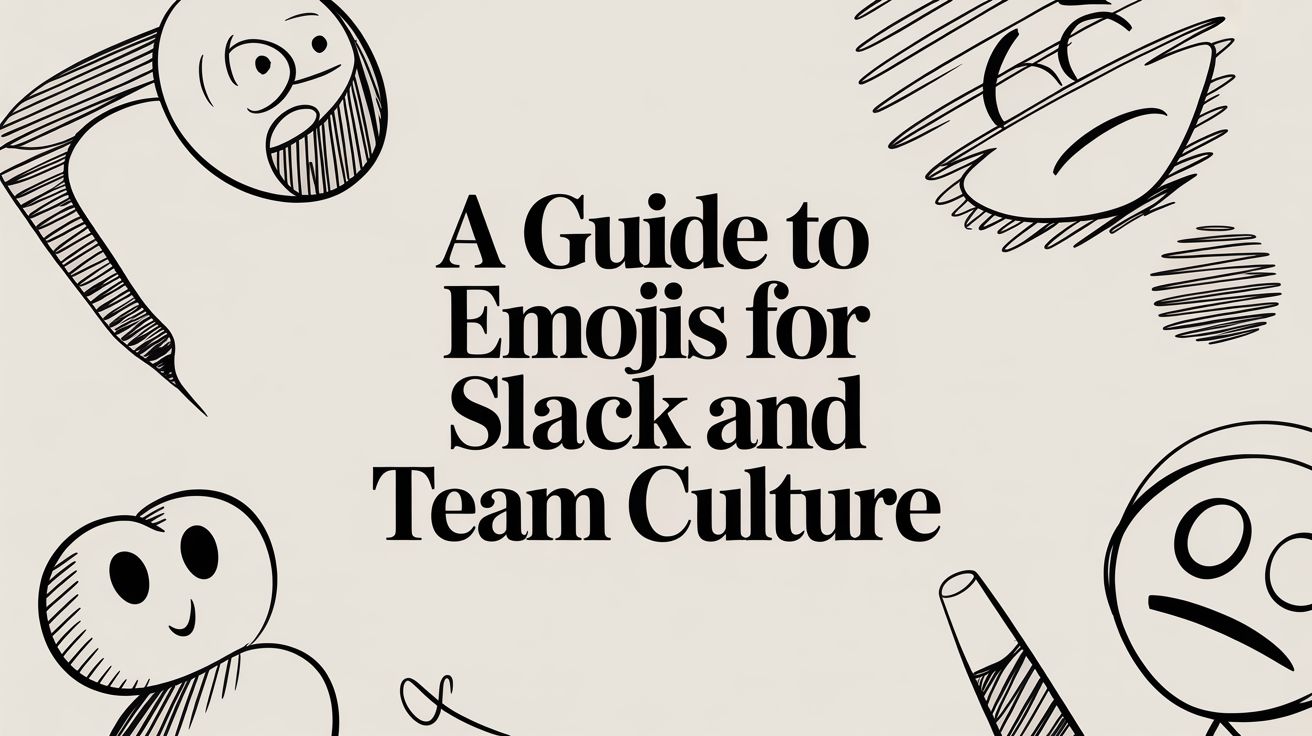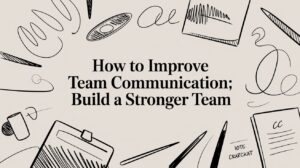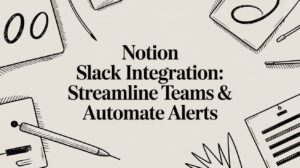Emojis for Slack can sprinkle fun into your messages. It’s about weaving a powerful, non-verbal communication layer directly into the fabric of your digital workspace. These simple graphics are fundamental tools for adding crucial emotional context, reducing channel noise, and building a truly vibrant, connected team culture—especially when you’re not all in the same room.
Table of Contents
Why Emojis for Slack Are More Than Just Fun
When you’re working remotely, text-based communication can sometimes feel flat and impersonal. We’ve all been there. A simple message like, “Can we talk about the project?” could be read as a friendly check-in or a sign that something is seriously wrong, all depending on the recipient’s state of mind.
This is where emojis make all the difference. They bridge that emotional gap.
By adding a simple 😊, that same request instantly becomes a collaborative and approachable invitation. It’s a small change, but it’s one that helps build psychological safety, making team members feel more comfortable sharing ideas and giving feedback without worrying about how their words will land.
Decluttering Channels and Boosting Efficiency
One of the first things you’ll notice when your team adopts a shared emoji language is how much cleaner your channels become. Think about it: instead of a dozen people clogging up a thread with “Got it,” “Sounds good,” or “I agree,” a single message can just rack up reactions like 👍 or ✔️.
This isn’t just a minor tweak. When Slack’s own team started leaning into emoji reactions, they saw a massive drop in the total number of messages being sent. Reactions like :heavy_plus_sign: to show you’re on board or :clap: to celebrate became part of their common language, replacing entire reply chains and seriously cutting down the digital noise. For a practical example, a project manager might post an update and ask the team to react with 👀 to confirm they’ve read it, instead of getting ten separate “read it” messages.
Emojis are the body language of the digital world. They convey tone, intent, and emotion that text alone often misses, turning simple messages into meaningful interactions and acknowledgments.
Building Connection and Recognizing Contributions
Beyond just being efficient, emojis for Slack are a cornerstone of team recognition and connection. A well-timed 🎉 or 🏆 reaction to a colleague’s success is a small but incredibly powerful gesture of public appreciation. It makes achievements visible and helps create a culture where people’s hard work is seen and celebrated. For example, when a developer ships a new feature, a flood of 🚀 emojis from the team is an immediate and visible form of celebration that boosts morale.
The importance of team recognition cannot be overstated; it’s the fuel for employee engagement and retention. When people feel seen, they are more motivated, productive, and loyal. These little interactions are absolutely vital for morale and are a key part of effective virtual team building activities you can find at https://asantebot.com/blog/virtual-team-building-activities/. Over time, these moments add up, strengthening relationships and fostering cohesion in remote culture. They help bridge the gaps that naturally form when you’re not face-to-face, solidifying team bonds in a genuine way.
Crafting Your Team’s Visual Language with Custom Emojis
This is where the real fun begins. Moving beyond the standard emoji set is how your team’s personality truly starts to shine in Slack. While the default emojis are great, building a custom library lets you create a visual language that’s all your own—packed with inside jokes, company values, and project-specific icons that make daily chatter feel more personal.
It’s a small change that can transform Slack from a simple communication tool into a canvas for your company culture. You’re not just adding pictures; you’re creating shared symbols that reinforce who you are as a team. And the best part? It’s incredibly easy to get started.
The Technical Nuts and Bolts
Before you unleash a flood of new emojis, it’s good to know the basic technical specs. Following these simple rules ensures your creations look sharp and upload without a fuss, whether they’re static images or animated GIFs.
- Ideal Dimensions: Go for a square image, preferably 128×128 pixels. Slack resizes everything anyway, but starting with this size gives you the crispest result.
- File Size Limit: Keep it under 128 KB. This is especially crucial for animated GIFs if you want them to load quickly and not annoy your colleagues.
- Supported File Types: You can use PNG, JPG, or GIF files. I’m a big fan of PNGs because they support transparent backgrounds, which makes your emojis look clean against any Slack theme, light or dark.
Getting them into Slack is a breeze. Any member (unless your admin has locked things down) can just click the smiley face in the message box, hit “Add Emoji,” and upload their image. The only thing left to do is give it a name.
Naming Conventions Are Your Best Friend
Trust me on this: as your collection of custom emojis for slack grows, you’ll be glad you had a system. Without one, finding that perfect emoji turns into an endless scroll. That’s why a simple, intuitive naming convention is a lifesaver.
A great way to do this is by using prefixes to group related emojis. It makes them ridiculously easy to find with Slack’s auto-complete feature.
A Few Naming Ideas We’ve Seen Work Well:
- Team Prefixes: Think
team-design-logo,team-eng-mascot, orteam-marketing-win. For example, your engineering team might create a:team-eng-bug-squashed:emoji to celebrate fixing a tricky bug. - Project Codes: If you’re working on a project codenamed “Falcon,” you could use
proj-falcon-launch,proj-falcon-bug, andproj-falcon-approved. Reacting with:proj-falcon-approved:on a design mockup becomes a clear, official sign-off. - Recognition Emojis: Group all your praise emojis together with something like
rec-kudos,rec-teamwork, orrec-innovate. This makes it simple for anyone to find the right emoji to celebrate a colleague. - Status Indicators:
status-wip(work in progress),status-review, orstatus-blockedare perfect for quick visual updates in project channels. A designer could add a:status-review:reaction to their own post to signal it’s ready for feedback.
This kind of structure stops your emoji library from descending into chaos and makes it a genuinely useful tool for the whole team.
A well-named emoji library isn’t just about being tidy. It’s about making your team’s unique cultural language accessible to everyone, especially new hires. It turns inside jokes and team values into searchable, shareable moments.
Ultimately, custom emojis are a powerful way to weave your culture directly into your workspace. From celebrating a launch with a unique rocket ship icon to sharing a laugh over a team-specific meme, these tiny images build real connections. They’re a constant, visual reminder of what brings your team together, making work feel a lot more human.
Building a Powerful Recognition Program with Emojis
Custom emojis are so much more than digital flair. Think of them as the building blocks for a genuine, automated team recognition program. When you elevate certain emojis for Slack from simple reactions into potent symbols of appreciation, you start to shape your company culture actively. This is how you move praise from something sporadic to a consistent, visible, and deeply ingrained habit.
Imagine creating dedicated emojis like :kudos:, :team-player:, or :above-and-beyond:. These aren’t just for fun—they’re triggers. Each one can carry a specific meaning tied directly to your company’s core values, making recognition both effortless and incredibly meaningful. When a teammate uses one, it’s not just a thumbs-up; it’s a specific nod to a job well done. For instance, using :above-and-beyond: on a message where a colleague stayed late to help a customer signifies a powerful, value-aligned action.
Automating Appreciation for Maximum Impact
The real magic happens when you hook these special emojis into an automated workflow. With a tool like AsanteBot, you can build a system where reacting to a message with a designated emoji—let’s say :kudos:—automatically kicks off a public shout-out.
This simple action can grab the original message and instantly post it into a dedicated channel like #wins or #recognition for everyone to see. This kind of simple automation achieves several key things at once:
- Amplifies Recognition: It takes a quiet “thank you” in a direct message or small channel and puts it on center stage. This not only makes the recipient feel truly valued but also inspires others.
- Creates Consistency: It completely removes the friction of remembering to post in the recognition channel later. Appreciation happens in the moment, every single time.
- Gathers Data: Over time, you can actually track which recognition emojis get used the most. This helps you spot patterns of positive behavior and even identify your most active culture champions.
This visual gives you a quick look at the basic steps for getting your custom recognition emojis up and running in your Slack workspace.
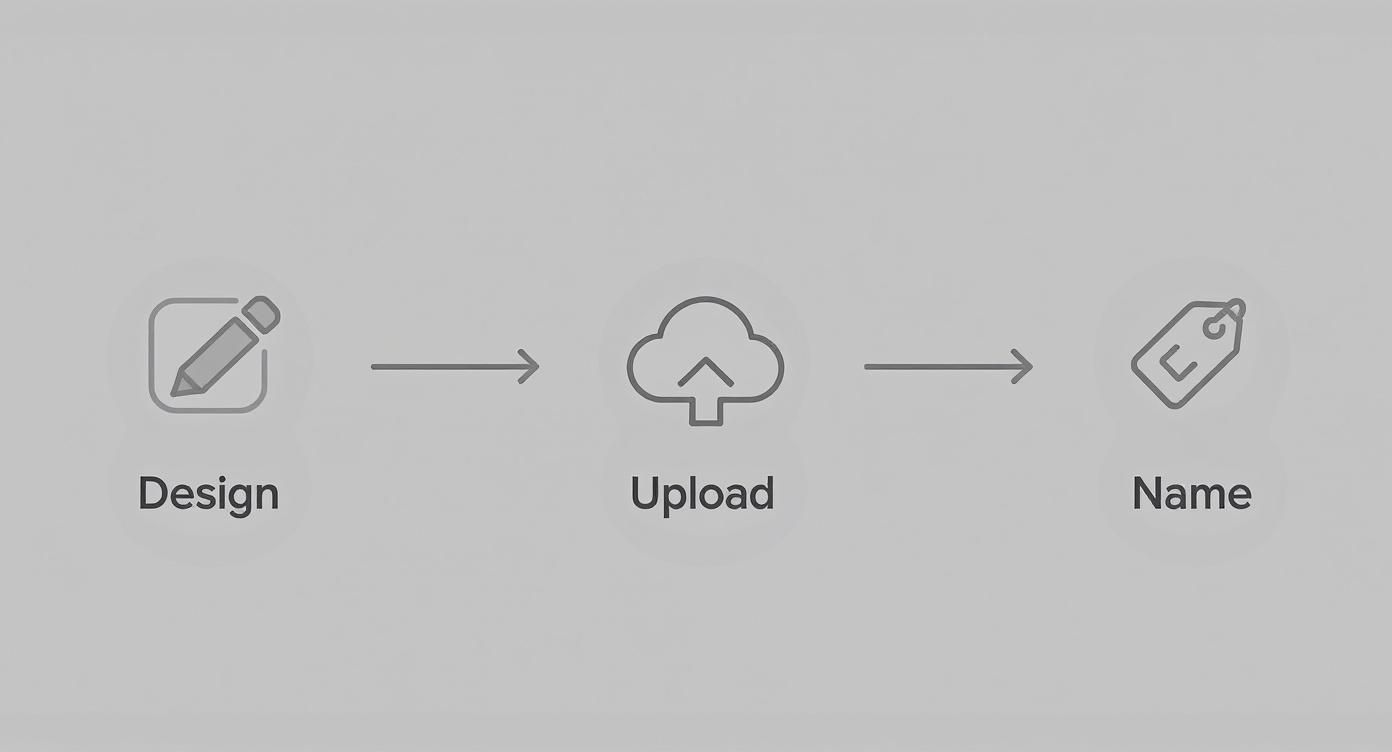
From a simple idea for an emoji to a fully functional and named icon, this process is the first real step toward building a more dynamic recognition system that people will actually use.
Why Team Recognition Matters So Much
A structured recognition program isn’t just a “nice-to-have” anymore. Consistent and visible appreciation is directly tied to higher employee engagement, motivation, and retention. The importance of team recognition lies in its ability to reinforce positive behaviors and make employees feel valued. When employees feel their contributions are seen and valued, they are 73% less likely to feel burned out. This creates a healthier, more productive, and more innovative work environment.
Turning recognition into a daily habit transforms it from a top-down corporate initiative into a peer-to-peer cultural norm. It democratizes appreciation, empowering everyone to celebrate the great work happening around them.
This creates a positive feedback loop where recognized employees are more motivated, and their colleagues are inspired to contribute in similar ways. Giving effective praise is a skill, and encouraging it can seriously boost morale. For more ideas, looking at some positive feedback examples can help your team learn how to craft more impactful messages.
Custom Emoji Ideas to Boost Your Team Culture
To get started, think about the specific behaviors and values you want to see more of on your team. Then you can create custom emojis that represent them directly.
I’ve put together a few ideas here to get your own creative juices flowing as you build out your recognition library.
| Category | Emoji Name Idea | Purpose & Example Usage |
|---|---|---|
| Collaboration | :team-player: |
Used when a colleague goes out of their way to help others succeed on a shared goal. For example, reacting to a message where someone from marketing created a deck for the sales team on short notice. |
| Innovation | :big-idea: |
Perfect for recognizing creative problem-solving or a groundbreaking new concept. For instance, use it when a team member suggests a new workflow that saves everyone hours. |
| Customer Focus | :client-love: |
A great way to celebrate positive feedback from a customer or a job well done for a client. Ideal for reacting to a screenshot of a glowing customer email shared in a channel. |
| Execution | :crushed-it: |
For celebrating the successful completion of a difficult project or hitting a major milestone. Use this when the project manager announces that a major feature has been successfully deployed. |
This is just a starting point, of course. The best emoji libraries are the ones that reflect a company’s unique personality and values.
For those looking for even more advanced usage and automation, especially within larger recognition programs, you might even consider how to create your own Slack bot to further streamline these emoji-based acknowledgments. By thoughtfully building a recognition program around your custom emojis, you’re creating a powerful, self-sustaining engine for a positive company culture—right inside Slack.
Setting Some Ground Rules: Emoji Etiquette and Best Practices
A great library of custom emojis can absolutely supercharge your team’s communication in Slack. But without a shared understanding, it can also get messy. What one person sees as a quick, efficient sign-off, another might read as dismissive or even passive-aggressive. The key to making sure your emojis are always helpful—not hurtful—is to establish some clear guidelines.
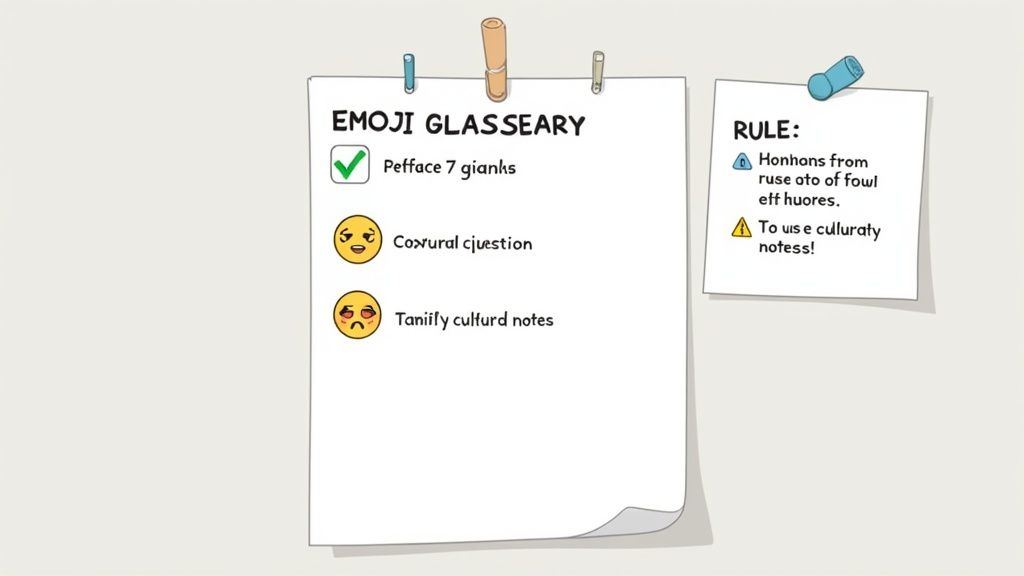
Don’t worry, this doesn’t mean you need to write a dense, formal rulebook. A simple “emoji glossary” can work wonders. Just create a pinned post in your #general channel or a dedicated page in your company wiki. The whole point is to define what your team’s custom emojis actually mean and outline a few best practices.
This has become increasingly important as emojis have woven their way into our work lives. By the early 2020s, they had started acting as unofficial status signals, even in places like performance reviews. Think about it: a single 👍 reaction to carefully written feedback could feel mocking. Silence after a big decision might be interpreted as disagreement. To get ahead of these mix-ups, forward-thinking teams began creating glossaries to clarify intent—like using a custom raccoon emoji to flag when a conversation is getting off-topic politely. You can dive deeper into how emojis are shaping workplace dynamics for more on this.
Creating Your Emoji for Slack Glossary
Your glossary should be a living document that’s easy for everyone to find and contribute to. It’s the go-to reference, especially for new folks, making sure everyone is speaking the same visual language.
A good place to start is by listing your custom recognition emojis and what you want them to mean:
:kudos:– Use this to celebrate a job well done or acknowledge someone’s extra effort. Example: React to a message where a teammate shares their completed report.:team-player:– Perfect for recognizing a colleague who went out of their way to help someone else. Example: Use this when someone volunteers to cover for a sick teammate.:big-idea:– Slap this on a message to praise an innovative thought or a really creative solution. Example: Add this reaction when someone proposes a novel approach in a brainstorming thread.
From there, add any project- or team-specific icons you have. For instance, :proj-phoenix-launch: could be your official signal that a key milestone for Project Phoenix is complete. Defining these prevents them from becoming inside jokes that might make some team members feel left out.
Setting General Etiquette Guidelines
Besides just defining emojis, it’s a good idea to lay out a few general principles. This helps guide behavior and head off common communication blunders. Consider adding tips that encourage people to be more thoughtful in how they communicate and recognize one another.
A clear set of emoji guidelines isn’t about restricting creativity; it’s about building a shared context. It ensures that every reaction, from a simple checkmark to a custom trophy, strengthens communication rather than complicates it.
Here are a few helpful guidelines to consider including:
- Be Mindful of Context. A stream of party poppers is fantastic in a
#winschannel, but it’s probably distracting during a serious discussion in an incident channel. - Avoid Ambiguity in Important Replies. When someone asks a critical question, it’s almost always better to type out a clear “Yes” or “No” in a thread instead of just reacting. A 👍 could mean “I agree,” “I’ve seen this,” or “I’ll do it”—that’s a recipe for confusion.
- Consider Cultural Nuances. Did you know the “thumbs-up” emoji can be offensive in some cultures? For global teams, it’s smart to encourage more universally positive emojis, like a simple smile or clapping hands.
By creating this shared understanding, you’re giving your team a tool that builds bridges, amplifies recognition, and ultimately makes work feel more connected and positive.
Measuring the Impact of Your Emoji Strategy
So, you’ve rolled out a brilliant emoji strategy. That’s a great start, but how do you know if it’s actually working? To move beyond a simple “gut feeling,” you need to look at some real data. By tracking a few key metrics and, just as importantly, asking your team for their thoughts, you can prove the value of your efforts and make smart adjustments along the way.
This doesn’t have to be some massive, complicated project. The real goal is to figure out if your custom emojis for Slack are genuinely making team communication better, giving morale a little boost, and encouraging people to recognize each other more often. When you can point to a positive trend, you’ve got solid proof that emojis are a strategic tool, not just a fun little distraction.
Tracking Usage and Engagement
One of the most straightforward ways to see what’s happening is to simply watch how often your recognition emojis are being used. Are people using emojis like :kudos: or :team-player: more this month compared to last month? A steady increase is a fantastic sign that your team is getting comfortable with giving and receiving peer-to-peer praise.
Many recognition platforms, including tools like AsanteBot, have built-in dashboards that do the heavy lifting for you. You can quickly see who’s giving and receiving the most shout-outs, which emojis are the most popular, and how these trends change over time. This kind of data is gold for identifying your cultural champions and spotting the teams where appreciation is really taking off.
Gathering Qualitative Feedback
Numbers tell you the what, but qualitative feedback tells you the why. You absolutely need to understand how your team feels about the whole emoji initiative. Thankfully, you can do this easily right inside Slack.
- Run a quick Slack Poll: Keep it simple. Ask something direct like, “Do our custom emojis make it easier to give recognition?” with “Yes,” “No,” or “Somewhat” as the options.
- Send out a short survey: Use a tool like Polly or even a Google Form for slightly more detailed questions. You could ask if emojis have made communication clearer or if they help create a more positive vibe at work.
Ultimately, the real measure of success is whether your team feels more connected. A great emoji strategy makes people feel seen and valued, turning tiny digital interactions into genuinely meaningful moments.
This isn’t just a hunch. A recent Slack survey highlighted this, finding that 67% of people feel closer to colleagues who “get” their emoji use. Custom emojis take this to another level. Just look at a company like Duolingo, which has over 1,000 custom icons to build its unique, playful culture. You can discover more insights about emoji use at work and see how powerful they can be.
By combining complex usage data with direct feedback from your team, you get the full story of your strategy’s success.
Answering Your Top Slack Emoji Questions
As you start getting more strategic with your emojis, you’ll naturally run into a few questions. Let’s tackle some of the most common ones we hear from teams who are building out their own emoji-based recognition programs.
How Many Custom Emojis Can You Actually Have?
This is probably the most frequent question, and thankfully, the answer is great news for most teams. If you’re on the free version of Slack, you get a massive 10,000 custom emoji slots. Honestly, that’s more than enough for the vast majority of companies to create a really vibrant and unique visual language.
For organizations on a paid plan—such as Pro, Business+, or Enterprise Grid—the ceiling disappears entirely. You get unlimited custom emoji uploads.
Is It Unprofessional to Use Many Emojis in Slack?
This one is less about a universal rule and more about your specific company culture. In modern digital-first workplaces, emojis aren’t just for fun; they’re a vital tool for adding emotional context and making communication more straightforward and faster. Using them for things like team recognition or quick project sign-offs is actually a sign of an efficient, well-connected team.
Professionalism isn’t about banning emojis. It’s about having a shared understanding of how and when to use them. A single, well-chosen emoji can add clarity to a message, while a flood of random icons in a serious channel can just create noise.
The best way to handle this is to create a simple emoji guide or a short section in your communication policy. It gets everyone on the same page and keeps things effective without feeling stuffy.
What Are the Best Free Tools for Creating Emojis?
You definitely don’t need a design background to make awesome custom emojis. There are a bunch of fantastic, free tools out there that make it incredibly simple.
- Slack Emoji Generator: This is a classic for a reason. It’s perfect for quickly slapping some text onto an existing emoji template, which is great for creating simple, text-based reactions like
:good-question:or:approved:. - Canva and Figma: If you want something a bit more polished or branded, these free design tools are your best bet. Canva and Figma give you total control to build high-quality, custom icons from the ground up.
- GIPHY’s GIF Maker: Looking to add some motion? GIPHY has a super intuitive tool that lets you turn short video clips or a series of images into animated emoji GIFs.
Building team recognition into your daily workflow is one of the most powerful things you can do for morale and engagement, and a smart emoji strategy makes it feel effortless.
Ready to turn recognition into a daily habit? AsanteBot makes it easy to build a culture of appreciation right inside Slack. Start your free trial today and see the difference it makes.
